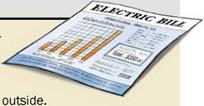Oversize Units Dehumidify Poorly and Waste Money
Approximately two-thirds of all residential air conditioners are too large. According to Bruce Harley, an HVAC consultant with Conservation Services Group in Westbor- ough, Mass., these oversize units "will cool your house, but they’re not necessarily
designed to run efficiently." The first problem is that they dehumidify poorly. Oversize units satisfy the temperature at the thermostat so quickly that only a little moisture has time to condense on the evaporator coil. This phenomenon is known as short cycling, and it’s more of a problem in humid climates. If cycles are very short, moisture on the coil can evaporate back into the house before it drains away.
Second, air-conditioning units are least efficient when they start up. It can take 15 minutes to reach operating efficiency, so oversize units run more short cycles, and more of their time is spent running in the least efficient part of the cycle. As a result, they use more energy, and costs to operate them run 20% to 30% higher than for properly sized systems. Finally, at an installed
Reducing Your Cooling Needs
 Air conditioners consume about two-thirds of electricity use during peak summer periods. Save money by making energy-efficient improvements before installing a new air-conditioning system.
Air conditioners consume about two-thirds of electricity use during peak summer periods. Save money by making energy-efficient improvements before installing a new air-conditioning system.
• A tight, well-insulated building reduces cooling needs by keeping warm, humid air
• Buy high-performance, low-e, argon-filled windows to reduce solar gain, which accounts for up to 70% of the cooling load on air-conditioning systems.
• Wide overhangs, trees, or vegetation is helpful. East-west glass is more of a problem than south-facing glass in summer.
• Use radiant barriers on the underside of uninsulated roof rafters if the HVAC equipment is in the attic; otherwise, just insulate the attic. In addition, insulate the ductwork.
• Install smart thermostats that turn off the air-conditioning when it’s not needed and then bring the house to the right temperature before you arrive home.
cost of around $1,000 per ton, oversize systems cost more. Why pay for 5 tons if 21/2 will do the job?
Smaller systems use less energy and remove more moisture because they run long enough to reach peak efficiency. So what’s the right size for an air-conditioning system? It depends.
The standard method for calculating the proper size for a residential central airconditioning system is found in ACCA’s (Air Conditioning Contractors of America) Manual J—Residential Load Calculation by Hank Rutkowski, P. E. It’s a methodical approach to arrive at room-by-room cooling loads for sizing ducts and whole-house systems. The room-by-room totals are important because you can’t design a duct system properly without this calculation.
Manual J takes into account and averages solar-heat gains, which don’t peak in all rooms at the same time. It also includes the house’s orientation to the sun and shading, which greatly affect the cooling load as well
as the insulation values of walls, ceilings, and floors. Window types, locations, and specifications as well as internal-heat gains (people, lighting, and appliances) also are figured in.
The right-size system is not a rule-of – thumb amount derived from the square footage of a house. In her book AirConditioning America (Johns Hopkins University Press, 1998), Gail Cooper writes that air-conditioning engineers 100 years ago called sizing by the rule-of-thumb method "futile and foolish." According to the folks that I’ve talked to, that remains true today.






Leave a reply